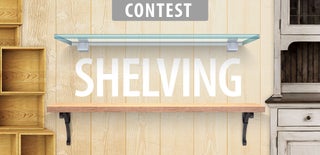Introduction: Little Tables - Dorm Room Bed Stands
As I moved into my dorm a few months ago, one of the things that I noticed that really annoyed me was that there was no good place to put my lamp so that I could read without keeping my roommate up with the overhead light. My first idea was to zip tie my lamp to my bed, but this was ugly and had a penchant for scratching me. I decided that I needed to make a little table to keep my lamp on (and maybe a few more to keep my other stuff on.
I went to the shop in the engineering building and found some chunks of plastic sitting in the freebie bin. I played around with some ideas, and finally decided on this one, which sits on the headrail to my bed and is held tightly to the bed by a small wedge.
Step 1: Choosing Your Materials
The first step to doing any project is choosing your materials. I found a bunch of samples of different thermoplastics in the freebie bin in my school's machine shop, but you could use wood, metal or whatever combination of materials you want. The dimensions of the material that you select will ultimately determine the dimensions of the cuts you need to make too. I choose 2 pieces of plastic, one that was 5" by 5" by 0.352" and another that was 5" by 5" by 0.523" These dimensions determined the maximum amount of space that I could get out of the table and how far I could support it out from the bed.
Step 2: Dimensioning Your Table
The next step for me was to make up the dimensions of the supports for my table. I didn't care very much about most of the dimensions, but I wanted the tabletop to be flush with the top of the supports and I wanted the supports to fit pretty snugly to the bed. those two were the only measurements that were super important. Other than that the rest were just made up by me as I went along by eyeing it up while on the mill that Iw as using and going for it. You don't at all need a mill to do this project, you could try it with a bandsaw, or even a hacksaw in all honesty. It is sort of a smoke em if you got em' situation.
Step 3: Fabrication and Assembly
The next step was to fabricate the entire thing. I used a mill and gang cut both supports to make sure that they were completely identical. I used 10-32 bolts to attach the table top to the supports, although gluing them would also work. If I could do it again I would probably have used 10-24 bolts instead. I wanted to be able to easily take apart the table so that I could modify the pieces if I wanted to. The final assembly looked like this. You can see that the table top is flush with the top of the supports. The supports are also centered on the table top with a square bolt pattern. The heads of the bolts are countersunk into the tabletop just enough to keep them from being exposed.
Step 4: Fin.
That's the end of my first instructable -- I hope you enjoyed! I would love constructive criticism and good luck building your own!

Participated in the
Shelving Contest 2016











